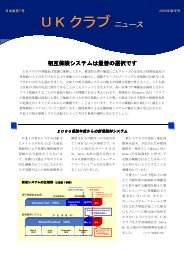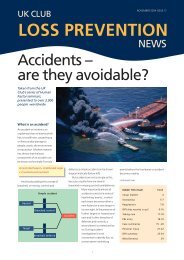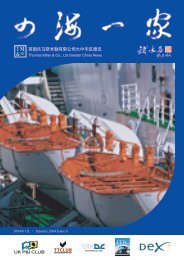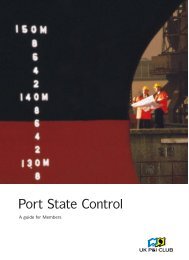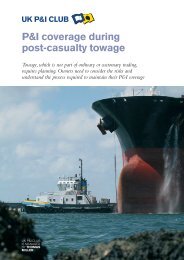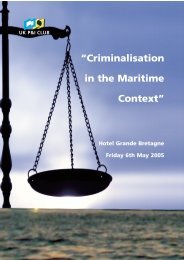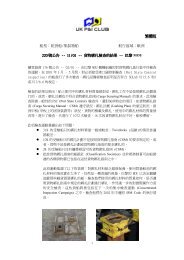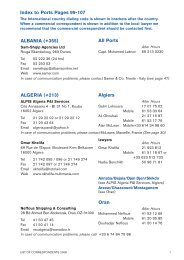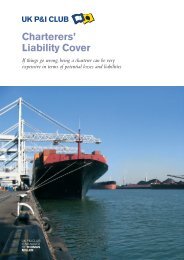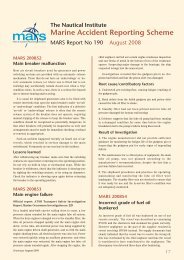Read full text
Read full text
Read full text
- No tags were found...
You also want an ePaper? Increase the reach of your titles
YUMPU automatically turns print PDFs into web optimized ePapers that Google loves.
successful, the licence being granted at a formal ceremony in May 1989. The UK Club’s Japan branch started doingbusiness a month later.In Sweden there was also the problem of competing with a well-established local club, described by RexPalmer: Historically, Scandinavian shipowners much preferred to place all their marine insurances through one company.They did not like to have to go to a hull underwriter in one direction and quite another direction for P & I. So the Swedishclub in particular was very difficult to compete with because it had both facilities. We therefore came to an arrangement witha big Swedish insurance company with strong lines in hull and cargo business, Hansa, and through them in 1954 set up acompany called Indemnitas.Actively to do business in Sweden as a foreign insurer required a licence, and we could obtain that licence with the helpof Hansa. As a domestic insurer, they could guarantee to the Swedish authorities the required level of solvency of the club.It cost no money to obtain the licence under that arrangement. Indemnitas became the fronting office for the UK Club inSweden. Swedish shipowners could go to Indemnitas to place their P & I with the UK Club. If they were interested in hullinsurance also they could be channelled to Hansa and vice versa.The other Scandinavian country in which the club has had an enduring involvement is Finland, where thedirectly entered tonnage, some of it pre-dating World War I, was supplemented from 1951 with reinsurance contracts.Business in Denmark and Norway, where there was an exceptional brief boom during the 1960s throughthe individual efforts of John Shearer, has not been significant. The two local clubs, Gard and Skuld, are wellestablished there.A nation that might have been expected to develop a P & I business of its own was France, which had centralisedinterests in Africa, Asia and the Middle East. Although the need was there, perhaps one of the main reasonsit could not be fulfilled was the French form of mutual, which could only exist and act according to a setof strict regulations. It lacked the pragmatic Anglo-Saxon approach. As early as 1882 the Grande CompagnieReinsurances proposed entering a large fleet of steamers with the UK Club but the proposal seems to havefoundered on the impossibility of obtaining a London bankers’ guarantee for the payment of calls.Not until 1926 was the first French fleet, that of grain shippers Louis Dreyfus, entered. This was followedby the wartime entry, in late 1943, of some Free French ships. The major influx took place from 1952, primarilyas a result of a decision by the Cour de Cassation on the Lamoricière, which opened up the possibility of unlimitedliability on shipowners, cover for which was not available from French insurance companies. A more recentappeal of the club is oil pollution cover, the Brittany coast being particularly vulnerable, as was demonstrated in1978 when the Amoco Cadiz (entered in the London Club) lost her steering and was driven on to rocks, broke upand spilled 230,000 tons of crude oil on to the region’s beaches and rich fishing grounds. That led to the formationof a clean-up group, Mission de la Mer, which helped Morocco in 1990 when its coast was threatened fromthe damaged Iranian tanker Khark 5.Beneath national and cultural differences, shipowners’ experiences and priorities, successful P & I comedown to the chemistry of individuals developing a bond. During World War I, in the battle of the Dogger Bank,John Essberger commanded a German cruiser and Dawson Miller a British destroyer, on which an experimentalsix-inch gun was mounted. The Germans got a nasty surprise when their cruiser was fired on with a six-inchshell, while the British, out-gunned and out-ranged, thought discretion the better part of valour and retreated.The Germans, thinking this manoeuvre was to lure them into a trap, did likewise. Nobody was injured in theskirmish. After the war, when the two men met and realised they had faced one another at sea, Essberger toldDawson how unsporting a six-inch gun was on a destroyer and entered his own ships. The relationship so forged




